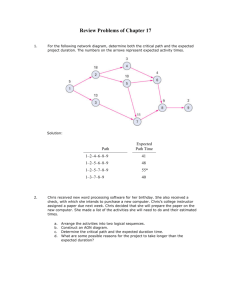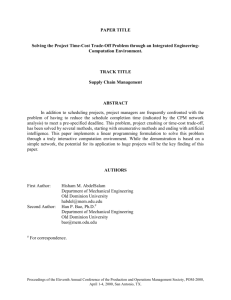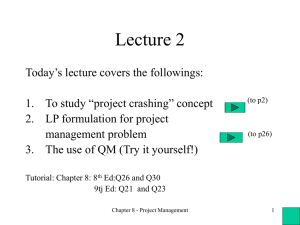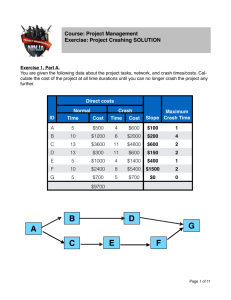Cost & Time and Also Minimum Project Duration Using Alternative
advertisement
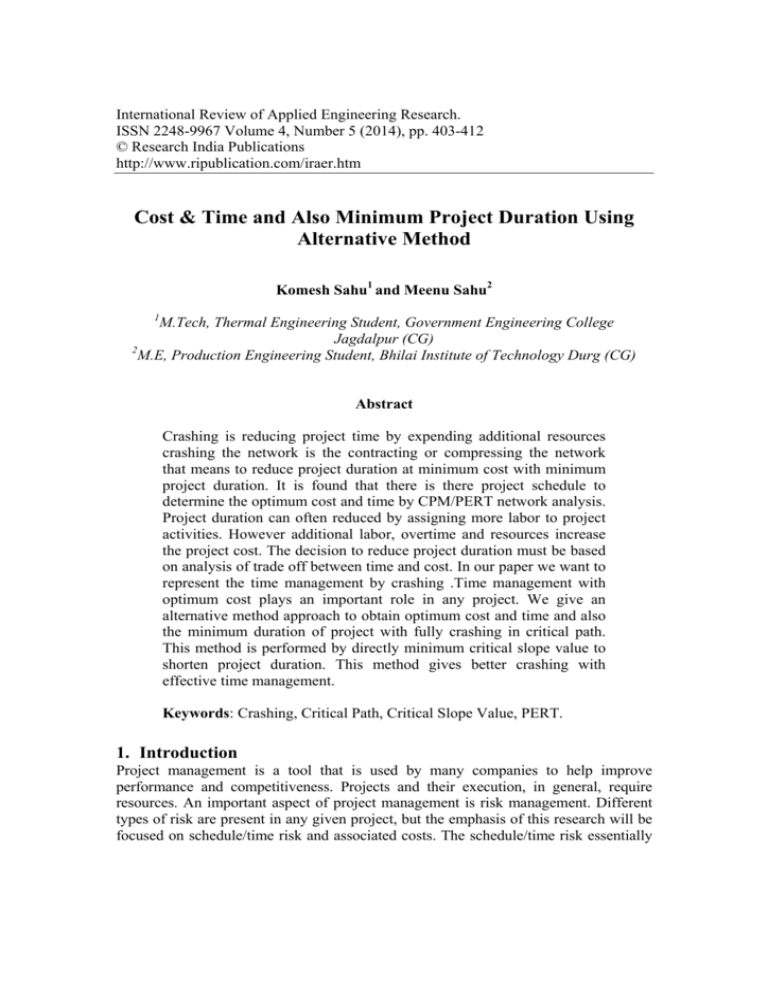
International Review of Applied Engineering Research. ISSN 2248-9967 Volume 4, Number 5 (2014), pp. 403-412 © Research India Publications http://www.ripublication.com/iraer.htm Cost & Time and Also Minimum Project Duration Using Alternative Method Komesh Sahu1 and Meenu Sahu2 1 M.Tech, Thermal Engineering Student, Government Engineering College Jagdalpur (CG) 2 M.E, Production Engineering Student, Bhilai Institute of Technology Durg (CG) Abstract Crashing is reducing project time by expending additional resources crashing the network is the contracting or compressing the network that means to reduce project duration at minimum cost with minimum project duration. It is found that there is there project schedule to determine the optimum cost and time by CPM/PERT network analysis. Project duration can often reduced by assigning more labor to project activities. However additional labor, overtime and resources increase the project cost. The decision to reduce project duration must be based on analysis of trade off between time and cost. In our paper we want to represent the time management by crashing .Time management with optimum cost plays an important role in any project. We give an alternative method approach to obtain optimum cost and time and also the minimum duration of project with fully crashing in critical path. This method is performed by directly minimum critical slope value to shorten project duration. This method gives better crashing with effective time management. Keywords: Crashing, Critical Path, Critical Slope Value, PERT. 1. Introduction Project management is a tool that is used by many companies to help improve performance and competitiveness. Projects and their execution, in general, require resources. An important aspect of project management is risk management. Different types of risk are present in any given project, but the emphasis of this research will be focused on schedule/time risk and associated costs. The schedule/time risk essentially 404 Komesh Sahu & Meenu Sahu implies not completing project activities on time, resulting in a late completion of the project. Late project completion generally has negative effects for the company such as penalty costs and customer dissatisfaction. If a project is running late project managers might be able to bring the project back on track by incorporating additional resources (Eisner, 2002). In project management, this method of mitigating risk is known as crashing. The traditional method of crashing CPM/PERT networks only considers average activity times for the calculation of the critical path, ignoring the uncertainty related with the duration of the activities. Consequently, other paths that may have a high probability of becoming critical are ignored. As a way to overcome this issue, simulation can be used to model the stochastic nature of the durations of the activities. Incorporating stochastic durations in the crashing process allows the generation of the project completion time distribution and enables the analysis of the real effect that a specific crashing configuration may have on the project. 2. Theortical Background 2.1 Crashing Crashing refers to a particular variety of project schedule compression which is performed for the purposes of decreasing total period of time (also known as the total project schedule duration). The diminishing of the project duration typically take place after a careful and thorough analysis of all possible project duration minimization alternatives in which any and all methods to attain the maximum schedule duration for the least additional cost The objective of crashing a network is to determine the optimum project schedule. Crashing may also be required to expedite the execution of a project, irrespective of the increase in cost. Each phase of the software design consumes some resources and hence has cost associated with it. In most of the cases cost will vary to some extent with the amount of time consumed by the design of each phase .The total cost of project, which is aggregate of the activities costs will also depends upon the project duration, can be cut down to some extent. The aim is always to strike balance between the cost and time and to obtain an optimum software project schedule. An optimum minimum cost project schedule implies lowest possible cost and the associated time for the software project management. 2.2 Activity time-cost relationship A simple representation of the possible relationship between the duration of an activity and its direct costs appears in Fig. 1. Shortening the duration on an activity will normally increase its direct cost. A duration which implies minimum direct cost is called the normal duration and the minimum possible time tocomplete an activity is called crash duration, but at a maximum cost. The linear relationship shown above between these two points implies that any intermediate duration could also be chosen. It is possible that some intermediate point may represent the ideal or optimal tradeoff between time and cost for this activity. The slope of the line connecting the normal point (lower point) and the crash point (upper point) is called the cost slope of the activity. The slope of this line can be calculated mathematically by knowing the Cost & Time and Also Minimum Project Duration Using Alternative Method 405 coordinates of the normal and crash points: Cost slope = (crash cost-normal cost)/ (normal duration crash duration) As the activity duration is reduced, there is an increase in direct cost. A simple case arises in the use of over timework and premium wages to be paid for such overtime. Also overtime work is more prone to accidents and quality problems that must be corrected, so indirect costs may also increase. So, do not expect a linear relationship between duration and direct cost but convex function as shown in Fig. 2. Fig. 1: Linear time and cost trade-off for an activity. Fig. 2: Non-linear time and cost trade-off for an activity. 2.3 Project time-cost relationship Total project costs include both direct costs and indirect costs of performing the activities of the project. If each activity of the project is scheduled for the duration that results in the minimum direct cost (normal duration) then the time to complete the entire project might be too long and substantial penalties associated with the late project completion might be incurred. At the other extreme, a manager might choose to complete the activity in the minimum possible time, called crash duration, but at a maximum cost. Thus, planners perform what is called time cost trade-off analysis to shorten the project duration. This can be done by selecting some activities on the critical path to shorten their duration. As the direct cost for the project equals the sum 406 Komesh Sahu & Meenu Sahu of the direct costs of its activities, then the project direct cost will increase by decreasing its duration. On the other hand, the indirect cost will decrease by decreasing the project duration, as the indirect cost are almost a linear function with the project duration. Fig. 3: Project time-cost relationship. Figure 3 shows the direct and indirect cost relationships with the project duration. The project total time-cost relationship can be determined by adding up the direct cost and indirect cost values together. The optimum project duration can be determined as the project duration that results in the least project total cost. 3. Steps to Approach the Crashing Network 1. The crashing activity starting at least slope value in activity to be selected in critical path (CPM). 2. The project duration is crashing are starting in critical path because of the project duration is depend in critical path to be selected or work. 3. The crashing activity are starting the number of days / time is reduced in selected path (CPM) is directly dependent of unselected path. hence the unselected path is not away or overhead of the critical path. 4. The unselected path is less than or equal to the selected path at crashing duration. Example. The following table gives data on normal time and cost and crash time & cost for a project Table 1 Activity 1-2 2-3 2-4 Normal Crash Time COST(RS.)(CN) Time(weeks)(TC) Cost (weeks) (TN) (Rs.)(CN) 3 300 2 400 3 30 3 30 7 420 5 580 Cost & Time and Also Minimum Project Duration Using Alternative Method 2-5 9 3-5 5 4-5 0 5-6 6 6-7 4 6-8 13 7-8 10 Total cost = Rs.4220 720 250 0 320 400 780 1000 7 4 0 4 3 10 9 407 810 300 0 410 470 900 1200 The indirect cost per week is Rs.50. 1. Draw the network for the project & Critical path. 2. Find optimum time and optimum cost. 3. Determine minimum total time & corresponding cost. Table 2 Activity 1-2 2-3 2-4 2-5 3-5 4-5 5-6 6-7 6-8 7-8 Normal Crash ΔT ΔC Δc/ΔT TIME Cost (RS.) Time(Weeks) Cost (Rs.) (Weeks) (TN) (CN) (TC) (CN) 3 300 2 400 1 100 100 3 30 3 30 0 0 0 7 420 5 580 2 160 80 9 720 7 810 2 90 45 5 250 4 300 1 50 50 0 0 0 0 0 0 0 6 320 4 410 2 90 45 4 400 3 470 1 70 70 13 780 10 900 3 120 40 10 1000 9 1200 1 200 200 1. Draw the network of the proposed project. Fig. 4.1 Critical path starting towards end 1-2-3-5-6-7-8 = 31 weeks 1-2-5-6-8 = 30 weeks 408 Komesh Sahu & Meenu Sahu 1-2-5-6-7-8 = 32 weeks it is critical path (CPM) of the project duration. 2. Optimum time and optimum cost. Time scale diagram of critical path Fig. 4.2 Crashing in activity 2-5 in 1 week. Now we are identified their activity in critical path which can be crashed with the lowest cost slope that are to be chose as List activity 2-5 ΔC/ΔT = 45 Fig. 4.3 Crashing in activity 5-6 in 2 weeks Cost & Time and Also Minimum Project Duration Using Alternative Method Fig. 4.4 Crashing in activity 6-7 in 1 week. Fig. 4.5 Crashing in activity 1-2 in 1week Fig. 4.6 Crashing in activity 6-8 in 2 week 409 410 Komesh Sahu & Meenu Sahu Fig. 4.7 Now Crashing in activity 7-8 in 1 week. Fig. 4.8 Crashing in activity 3-5 in 1 week. Fig. 4.9 Again crashing in activity 2-5 in remain 1 week. Cost & Time and Also Minimum Project Duration Using Alternative Method 411 Fig. 4.10 The above results are summarized in the table below. Activity No. Represent Weeks Project Normal Indirect Fig. Saved Duration Direct Cost (Ic) Crashed Of Rs. In (Week) Cost Week Project (Dc) Crash Rs. CPM fig.4.2 32 4220 32 x 50=1600 2-5 1 fig.4.3 1 31 4220 31x 50=1550 5-6 2 fig.4.4 2 29 4220 29x 50=1450 6-7 1 fig.4.5 1 28 4220 28x 50=1400 1-2 1 fig.4.6 1 27 4220 27x 50=1350 6-8 2 fig.4.7 27 4220 27x 50=1350 7-8 1 fig.4.8 1 26 4220 26x 50=1300 3-5 1 fig.4.9 26 4220 26x 50=1300 2-5 1 fig.4.10 1 25 4220 25x 50=1250 • • Crash Cost (Cc) Rs. 0 1x45=45 45+2x45=135 Total Cost = Dc+Ic+Cc Rs. 5820 5815 135+1x70=205 5805 Least 5825 205+1x100=305 5875 305+2x40=385 5955 385+1x200=585 6105 585+1x50=635 6155 635+1x45=680 6150 The above table indicates the optimum cost (Rs.5805) and optimum duration (29 weeks) and also shows the maximum crashing after the project duration is 25weeks. The all project duration is crashing is dependent in critical path (CPM) because the duration is reduce in only crashing in critical path. 412 Komesh Sahu & Meenu Sahu 4. Result and Conclusion The time network is shown in figure all the activities are fully crashed .Thus the minimum projects duration is 25weeks .The complete crashing of the network from 32 weeks to 25 weeks. We see that all the activities on the critical path which could be crashed as per the given condition have been possible to further crash the project network. It is also to be noted that crashing of the non-critical activity will not change the project completion time. Hence, they will not be calculated. 4.1 Notation Direct cost Indirect cost Crash cost Normal time Normal cost Crash time Crash cost ∆C ∆T Dc Ic Cc TN CN TC Cc Cc - CN TN - TN Activity Critical path Dummy activity References [1] [2] [3] [4] [5] [6] [7] [8] [9] [10] [11] [12] [13] Bratley, P., B.L. Fox and L.E. Schrage, 1973. A Guide to Simulation. Springer-Verlag. Elmaghraby, S.E., 1977. Activity Networks: Project Planning and Control by Network Models. John Wiley, New York. Steve, P. Jr. and M.I. Dessouky, 1977. Solving the project time/cost tradeoff problem using the minimal cut concept. Manage.Sci., 24: 393-400. Rehab, R. and R.I. Carr, 1989. Time-cost trade-off among related activities. J. Construct. Eng. Manage., 115: 475-486. Pulat, P.S. and S.J. Horn, 1996. Time-resource tradeoff problem [project scheduling]. IEEE Trans. Eng. Manage., 43: 411-417. Walter, J.G., C. Strauss and M. Toth, 2000. Crashing of stochastic processes by sampling and optimization. Bus. Process Manage. J., 6 : 65-83. Kathryn, A.M., 2004. A simulation approach to the PERT/CPM: time-cost trade-off problem. Project Manage. J., 35: 31-38. Van Slyke, R.M., 1963. Monte carlo methods and the PERT problem. Operat. Res., 33: 141-143. 11. Ramini, S., 1986. A simulation approach to time cost trade-off in project network, modeling and simulation on microcomputers. Proceedings of the Conference, pp: 115120. 12. Johnson, G.A. and C.D. Schou, 1990. Expediting projects in PERT with stochastic time estimates. Project Manage. J., 21: 29-32. 13. Badiru, A.B., 1991. A simulation approach to Network analysis. Simulation, 57: 245255. 14. Feng, C.W., L. Liu and S.A. Burns, 2000. Stochastic construction time-cost tradeoff analysis. J. Comput. Civil Eng., 14: 117-126. 15. Grygo, E., 2002. Downscaling for better projects. InfoWorld, 62-63.
